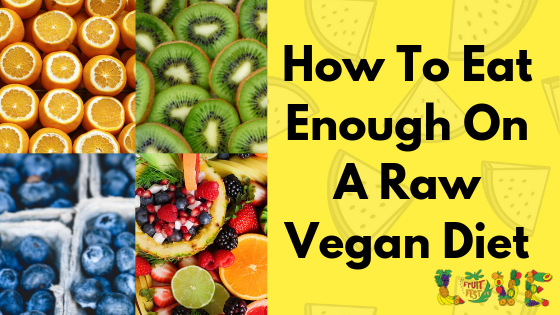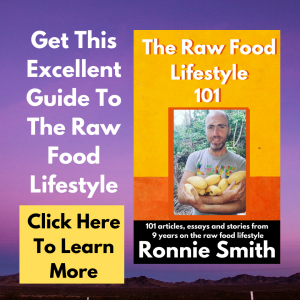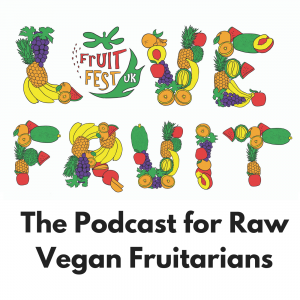How To Know You Are Eating ENOUGH On A Raw Vegan Diet
by Ronnie Smith

How To Know You Are Eating ENOUGH On A Raw Vegan Diet
One of the most controversial questions in the raw vegan world is “how much should we eat on a raw vegan diet”?
There are a number of differing opinions on this topic so it can be very confusing for a beginner.
You may also wonder whether you can simply follow your body’s own hunger cues. Unfortunately, this can be confusing on a raw diet as the body responds differently to a raw diet than to a cooked diet.
In this message I hope to go over some of the issues surrounding this question and give, hopefully, some very common sense guidance.
First off, we can perhaps throw out some ideas. For example some people claim that we should eat a particular weight of food. So they recommend you eat 2 pounds of food per day as long as it is raw.
This is too vague an answer. Different foods vary a lot in terms of the level of nutrition and calories so it just doesn’t make sense to use weight as a reliable measurement. 2 pounds of nuts is a lot different to 2 pounds of lettuce.
The most reliable way to know if you are eating enough is to track your weight. If you are losing weight (and this is not your intention) then you know you need to eat more. If you are gaining weight (and it is not your intention) then it is a good indication you are eating too much.
But exactly what are we eating too much of?
The most accurate way to measure the value of food in terms of the energy that it provides us is to measure the calories in a food. Some people may suggest that this is different when it comes to a raw food diet but there is little reason for anyone to believe it is different. There is some debate as to how accurate this process is, but it is the most accurate method we have.
If we can work out how many calories we need to maintain our weight and stay healthy then we could work out how much food we require and translate this to what is available to us on a raw vegan diet.
A method for determining how many calories we require comes from Dr Doug Graham’s book, the 80/10/10 Diet.
He states that we first work out our Basal Metabolic Rate. This is the energy we use if we were just to sit in bed and do nothing all day. In the case of a 150 pound person, their BMR would be 1500 calories. We figure this out simply by multiplying the weight of the individual in pounds by 10.
Once we have done this we must add on how many calories we use up in our day to day activities and exercise.
To get a more accurate reading you can use the Harris- Benedict equation for working out BMR and then multiplying this by an activity factor.
The average for a woman is around 1800 calories and for a man is around 2500 (per day).
If we translate that to raw food we have a few options. We can certainly make up these calories easily by eating nuts,seeds or oils as these substances are very dense in calories (mostly from fat).
However, to maintain a raw vegan diet long term it is important to feel good. When we eat a high proportion of our calories as fat we reduce our body’s ability to supply nutrients such as oxygen and sugar to the blood cells as efficiently as possible.
The ideal ratio of macronutrients in our diet is signified by the 80/10/10 proportion. At least 80% of our calories should therefore come from carbohydrates.
This matches the ratio that is inherent in most fruits. This is one of the many reasons that basing our raw food diet on fruit rather than fat is a better option.
Therefore, we simply now have to look at how many calories we require on a daily basis and aim to get most of those from fruit with a smaller percentage gained from vegetables, nuts and seeds.
For example, a woman requiring 1800 calories per day could make up her diet with 18 bananas. This would roughly be what she would require.
If she preferred more variety she could have 8 bananas (800 calories) , 6 large mangoes (approx 800 calories) and a large salad with some avocado (approximately 200 calories).
Someone looking at these quantities of food may start to think that this is “too much”. They are reacting to the volume of the food. With raw food we must eat a greater volume of food to get the same calories as we did from cooked food.
If we do not, then we will struggle to maintain our weight and struggle to avoid the temptations of other foods. When you are satisfied from eating enough fruit you are much less likely to be tempted by less healthy foods.
BEWARE: Not eating ENOUGH is by far the biggest reason people struggle to feel good on this lifestyle long term or remain successful on it. It is also the reason we hear about “emaciated” raw vegans. Almost all of the time, people were simply not eating enough.
In conclusion:
1. Calories: Work out your daily calorie needs.
2. Fruits: Become familiar with the amount of calories in all of the common fruits and other raw foods that you eat.
3. Eat Enough fruit to satisfy the majority of your calorie needs and make up the rest with vegetables, salads and nuts and seeds (at first this will seem like A LOT of food. You will get used to this over time and enjoy the real feeling of satisfaction that comes with this)
4.Track Your Weight to see if you are eating too little or too much.
That’s about it.
You may wonder why you need to put this work in. Surely, if this is a more “natural diet” then our body should tell us all we need to know?
The problem with this is we simply don’t live in our natural environment and we were not brought up on our best diet. We have not learned from experience how much we need to eat to feel good.
I hope this works out for you, you can get back to me if you have some thoughts of your own.
How To Know You Are Eating ENOUGH On A Raw Vegan Diet One of the most controversial questions in the raw vegan world is “how much should we eat on a raw vegan diet”? There are a number of differing opinions on this topic so it can be very confusing for a beginner. You may…






